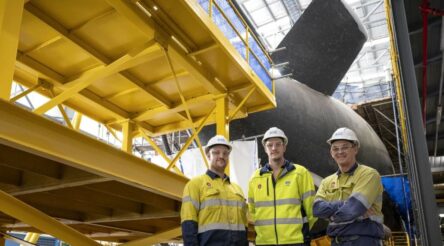BAE Systems beefs up frigate design, but what then is it?

By Peter Roberts
In the face of criticism that Australia is building the wrong type of naval vessel in a time of rising tension, BAE Systems Australia has revealed a more lethal, attack version of the Hunter class frigate it is building in Adelaide.
Conceived as a largely anti-submarine vessel, the nine Hunter class frigates under construction at the Osborne Naval Shipyard have been criticised as have other vessels being built for the navy as lacking enough firepower to deter would-be aggressors.
The federal government even ordered a Service Fleet Review in addition to the recent Defence Strategic Review to recommend whether we were getting the right ships at the right time.
With that review in the hands of the government, BAE Systems Australia CEO Ben Hudson has revealed designs and a model of an alternate Hunter design at the Indo Pacific Maritime expo in Sydney.
The updated Hunter loses a multi-purpose mission bay and replaces it with an additional 64 vertical launch missile cells, adding to the planned 32.
The vessel would also be able to mount eight more Naval Strike Missiles bringing that total to 16.
BAE Systems even said that the extra missiles could be added to the warship without affecting the overall cost or delivery timetable.
But do we really want to forgo anti-submarine capabilities – the bread and butter of the current ANZAC frigate fleet, in favour of maritime and land attack capabilities?
The biggest loss in the new design is a massive multi-mission bay that sat atop the Hunter, enabling future navy planners to house various unmanned underwater, sea surface and aerial systems which could be launched and recovered when needed.
This was one of the beauties of the original design – giving the ship a rare flexibility likely to become invaluable as autonomous and unmanned systems become more critical in defence.
More missiles is all very well, but they suggest a completely different role to the ant-submarine one.
We are going to continue to need to be able to protect our seaborne supply lanes in any future scenario.
Is it more or less likely that the navy’s mission will switch to attack and aggression? Maybe Hunter could become a mix of the two vessel types?
No doubt the Service Fleet Review has considered all these matters.
But the outcome will very much make clear what kind of Royal Australian Navy Australia wants to field in future.
Image: BAE Systems Australia
@aumanufacturing Sections
Analysis and Commentary Awards Defence Manufacturing News Podcast Technology Videos










